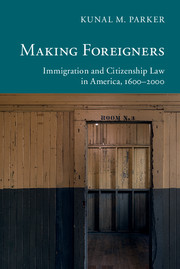Book contents
- Frontmatter
- Contents
- Preface and Acknowledgments
- 1 Introduction
- 2 Foreigners and Borders in British North America
- 3 Logics of Revolution
- 4 Blacks, Indians, and Other Aliens in Antebellum America
- 5 The Rise of the Federal Immigration Order
- 6 Closing the Gates in the Early Twentieth Century
- 7 A Rights Revolution?
- 8 Conclusion and Coda
- Bibliographic Essay
- Index
7 - A Rights Revolution?
Published online by Cambridge University Press: 05 September 2015
- Frontmatter
- Contents
- Preface and Acknowledgments
- 1 Introduction
- 2 Foreigners and Borders in British North America
- 3 Logics of Revolution
- 4 Blacks, Indians, and Other Aliens in Antebellum America
- 5 The Rise of the Federal Immigration Order
- 6 Closing the Gates in the Early Twentieth Century
- 7 A Rights Revolution?
- 8 Conclusion and Coda
- Bibliographic Essay
- Index
Summary
Introduction
In the aftermath of World War II, the United States emerged as the world's leading power. As the country plunged into the Cold War, the emergence of a vast military-industrial complex, combined with the expansion of consumer culture, resulted in a quarter century of robust economic growth. During this heyday of American capitalism, both Republicans and Democrats, but especially the latter, were open to state intervention in the economy and the funding of social programs.
During this period, newly emboldened by the United States’ victory over Fascism and its ideological struggle with the Soviet Union, the country's historically marginalized and subordinated groups demanded that it make good on its stated liberal and egalitarian commitments. The resulting “rights revolution” had the effect of strengthening individual rights, proscribing formal legal racism and sexism, and injecting a measure of equality into the polity. Various spaces – public and private, educational and residential, professional and recreational, political and civic – that had once been closed to blacks, Native Americans, Latinos, Asians, women, and others opened up through force of law. The constitutionalization of a “right to travel” throughout national territory dismantled the internal borders that states, counties, and localities had long set in place to control the influx and presence of the native-born poor. Between 1950 and 1980, the U.S. Supreme Court also made it much harder for the U.S. government to expatriate American citizens against their will and thereby to convert citizens into aliens. These developments did not by any means bring older hierarchies to an end, but they did much to diminish domestic groups’ enforced foreignness vis-à-vis the polity.
From the perspective of immigration and citizenship law, the post–World War II period was one of decidedly mixed consequences. One change that took place – a consequence of the country's Cold War commitments and its rights revolution – was both important and enduring. After 1965, race, ethnicity, and national origin were no longer formal bars to immigration and naturalization. If formal racial classifications fell away, however, critical features of the late-nineteenth- and early-twentieth-century immigration regime became entrenched.
- Type
- Chapter
- Information
- Making ForeignersImmigration and Citizenship Law in America, 1600–2000, pp. 185 - 220Publisher: Cambridge University PressPrint publication year: 2015



